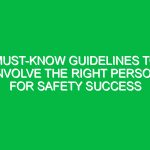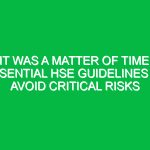“`html
Essential Guidelines for Safety in an Isolated Work Environment
Good morning team,
Today, we’re going to discuss a crucial topic that impacts our daily operations and overall safety: Essential Guidelines for Safety in an Isolated Work Environment. Working in isolation can present unique challenges, and it’s vital that we understand how to navigate these situations safely and effectively.
As we delve into this topic, remember that our safety is our top priority. By understanding the guidelines and Hazards associated with isolated work, we can maintain a safe working environment for everyone. Let’s get started!
Understanding Essential Guidelines for Safety in an Isolated Work Environment
The term isolated work environment refers to situations where employees work alone or are separated from immediate help or support. This can occur in various settings, such as remote job sites, maintenance tasks during off-hours, or even in large facilities where teams are dispersed.
Understanding the importance of safety in isolated environments is critical. When working alone, the risks associated with accidents, health emergencies, or equipment malfunctions can escalate quickly. The impact on employees’ daily operations is significant, as isolation can lead to increased stress and anxiety about safety.
One common misconception is that working alone means less productivity. In fact, when safety protocols are followed, employees can be just as productive, if not more so, when they feel secure and prepared for potential risks.
Key Hazards, Risks, and Safety Considerations
Isolated work environments come with specific hazards and risks that need to be addressed proactively. Here are some key considerations:
- Injury Risks: Without immediate support, injuries can become life-threatening. For example, a fall or equipment malfunction may not be discovered for hours if no one is nearby.
- Health Emergencies: Medical issues can arise unexpectedly. If an employee becomes ill or suffers an injury without immediate assistance, the consequences can be severe.
- Psychological Stress: Working alone can lead to feelings of isolation and stress, impacting mental health and decision-making.
- Environmental Factors: Weather conditions, wildlife encounters, or hazardous materials may pose additional risks in remote settings.
Ignoring safety protocols in these areas can lead to serious consequences, including injuries, legal ramifications, and reduced morale. It’s essential we take these risks seriously to ensure everyone returns home safely.
Best Practices, Procedures, & Actionable Advice
Now that we understand the hazards, let’s discuss Best Practices and Procedures to ensure safety when working in isolation:
1. Conduct Risk Assessments
Before commencing work, conduct a thorough risk assessment to identify potential hazards. This should include evaluating the work environment, equipment, and tasks involved. Documenting these findings helps in planning Safety Measures effectively.
2. Implement Communication Protocols
Establish clear communication protocols to ensure that isolated workers can easily reach out for help if needed. This may include:
- Using two-way radios or mobile phones with reliable coverage.
- Regular check-ins with a supervisor or team members to confirm safety.
- Setting up an emergency contact system that includes key personnel.
3. Use Personal Protective Equipment (PPE)
Ensure that all employees working in isolated environments are equipped with the appropriate PPE. This can vary based on the nature of the work but may include:
- Hard hats, gloves, and Safety Goggles.
- First aid kits readily available on-site.
- Reflective vests or clothing for visibility in low-light conditions.
4. Develop Emergency Plans
Having a well-defined emergency plan is crucial. This plan should outline procedures for various scenarios, such as:
- Medical emergencies and how to respond.
- Fire or chemical spills and evacuation routes.
- Severe weather guidelines for outdoor work.
5. Training and Awareness
Regular Training sessions should be conducted to reinforce safety protocols and ensure that all employees are aware of the risks associated with isolated work. Real-life case studies can be used to illustrate the importance of these practices:
- In a recent incident, a technician working alone suffered a fall and was unable to call for help. This highlights the need for effective communication and a buddy system.
- A Maintenance worker in a remote facility experienced a medical emergency but had not been trained on how to use their emergency communication device, resulting in delayed assistance.
Regulations, Standards, and Compliance
Compliance with safety Regulations is not just a legal obligation but a moral one. Here are some Standards to consider:
- OSHA Standards: The Occupational Safety and Health Administration outlines regulations for Workplace Safety, including guidelines for working alone.
- ISO Standards: International Organization for Standardization provides guidelines for safety management systems that can be applied to isolated work.
- Company Policies: Familiarize yourself with your company’s specific safety protocols and ensure adherence to all guidelines.
Compliance is critical as it protects employees and the organization from potential legal issues and enhances Workplace Safety culture.
Employee Engagement & Discussion
Now that we’ve discussed the guidelines for safety in an isolated work environment, I’d like to hear from you. What safety challenges have you encountered related to working alone? How do you think we can improve our Safety Measures in these situations?
Your insights are invaluable, and together we can foster a safer work environment. Please feel free to share your experiences and suggestions during our discussion.
Conclusion & Key Takeaways
In summary, understanding and applying essential guidelines for safety in an isolated work environment is vital for protecting ourselves and our colleagues. Key takeaways include:
- Conduct thorough risk assessments before starting work.
- Implement effective communication protocols and emergency plans.
- Utilize the appropriate PPE and ensure compliance with safety regulations.
- Engage in regular training and open discussions about safety.
Let’s prioritize safety and ensure that we all go home safe every day. Thank you for your attention and your commitment to maintaining a safe work environment!
“`


